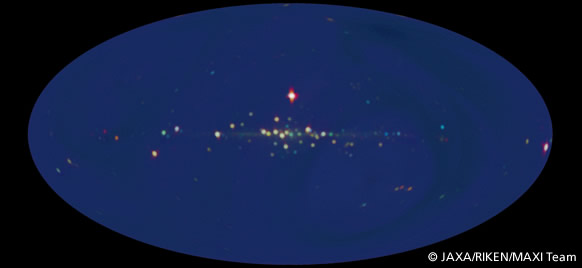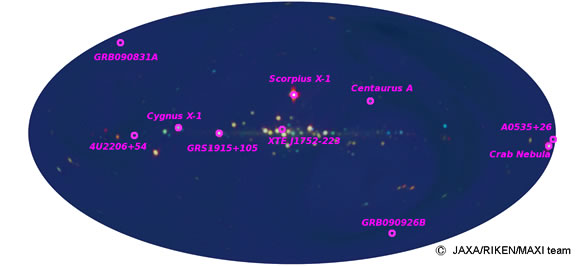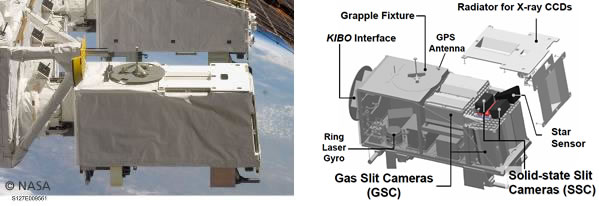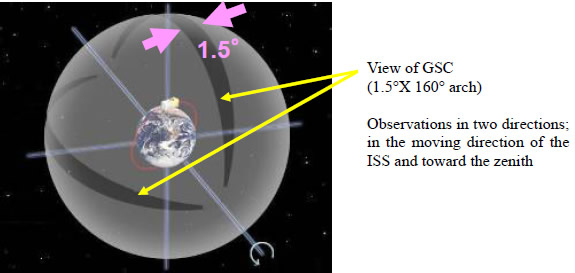Japanese Kibo Mission
MAXI acquires all-sky X-ray image in the fastest time
November 26, 2009 (JST)
Japan Aerospace Exploration Agency (JAXA)
RIKEN
The Japan Aerospace Exploration Agency (JAXA) and RIKEN have successfully acquired an all-sky X-ray image (Figure 1.) using the "Monitor of All-sky X-ray Image (MAXI)" installed on the Exposed Facility of the Japanese Experiment Module "Kibo." This quality image was achieved in the shortest period of time compared to other all-sky X-ray observation projects. In the future, it will be possible to repeatedly take this image every month or every few months.

Figure 1. All-sky X-ray image by the GSC of the MAXI
The image shows the all-sky in an oval shape on the "galactic coordinate" which indicates the Milky Way as a horizontal axis and the galactic center at the center of the image.
The image above was compiled using data acquired by the Gas Slit Camera (GSC), one of MAXI's onboard X-ray camera systems (Figure 3. in the Attachment), between August 15 and October 29, 2009 (Japan Standard Time.) (Please also refer to Figure 4. in the Attachment.) Sources plotted in red in this figure radiate low-energy X-rays, and those in blue emit high-energy X-rays.
In this image, nearly 180 X-ray sources can be recognized by the eye. Taking less than two months to complete, this is the world's quickest acquisition of an all-sky "color" X-ray image. This kind of all-sky X-ray image in a similar sensitivity and energy band was compiled by composing data obtained by the NASA satellite, HEAO-1, 30 years ago through its two-year survey. (http://antwrp.gsfc.nasa.gov/apod/ap960102.html)
In addition, the MAXI reported to an international mailing list of astronomers on five X-ray sources that have suddenly increased their brightness since the beginning of its mission. (A0535+26, GRB090831A, GRB090926B, XTE J1752-223 and 4U2206+54 in Figure 2.)

Figure 2. Major X-ray sources and brightened sources detected by MAXI
(For more details, please refer to the Attachment)
Through repeated observations, the MAXI monitors a variation of X-ray intensities of over 1000 X-ray sources in the sky in a span of a day to several months with an interval of 90 minutes, and takes all-sky moving images in "color" by X-ray. This is the first experiment to systematically monitor active X-ray sources outside the galaxy, such as quasars, over the all-sky with the high sensitivity of the MAXI in this time span. The limit of detection reaches one 1000th of the intensity of the "Crab Nebula," which is a standard source in observing the X-ray sky. As we continue these observations, sensitivity is expected to reach more than 10 times that of other all-sky X-ray observation equipment.
The MAXI team comprises not only JAXA and RIKEN scientists but also researchers from Osaka University, Tokyo Institute of Technology, Aoyama Gakuin University, Nihon University, Kyoto University, and the University of Miyazaki to carry out analysis and operations.
|
|
Attachment
The Monitor of All-sky X-ray Image (MAXI) was launched by the Space Shuttle Endeavour on July 16, 2009, and was attached to the Exposed Facility of the Japanese Experiment Module "Kibo" by JAXA Astronaut Koichi Wakata using the robotic arm on July 24. The initial checkout of all the onboard devices that started on August 3 was completed, and we are now accumulating observation data of X-ray sources. Acquired data is calibrated and processed to determine the position and intensity of each source with higher precision to be ready for the data release scheduled in mid December.
The MAXI project was proposed by RIKEN and chosen through an impartial selection process when JAXA solicited public ideas for initial utilization of the Kibo's Exposed Facility in April 1997. The MAXI was selected because it could become more viable when it was installed onto the Kibo's Exposed Facility from which the onboard devices could observe space directly.
As the MAXI can depend on the International Space Station (ISS) for basic functions including power supply, attitude control and communications, it is equipped with a larger detector. As a result, the MAXI can detect X-rays sources with a sensitivity 10 times more than other all-sky observation equipment. The MAXI disseminates information on X-ray novae or gamma(γ)-ray bursts, that are closely related to super novas and black holes, and promotes simultaneous observations by multiple wave lengths of lights and radio waves. In addition, the MAXI compiles a catalogue of all-sky X-ray sources to elucidate the nature of the variable universe, which contains active galaxies or some unknown factors such as darker black holes and neutron stars.
The achievements of the MAXI were reported at four international academic conferences held in Italy, the U.S. and other countries, and researchers in Japan as well as in other countries hold high expectations for the MAXI as a new all-sky X-ray monitor.
The MAXI carries both domestic and international expectations to conduct observations for at least two more years as "the eye of X-rays to look around the all-sky." We will continue our research based on our achievements in cooperation with other projects, for example, by requesting immediate observations by other X-ray and/or gamma-ray astronomical observatories that can perform detailed observations, including the X-ray Astronomy Satellite "SUZAKU," the Swift Gamma-ray Burst Satellite and Fermi Gamma-ray Satellite, a project that Japan also participates in, and the X-ray Astronomy Satellite "ASTRO-H."

Figure 3. MAXI Overview

Figure 4. All-sky Observation by MAXI
The Gas Slit Camera (GSC) has a fixed arch-shape view of 1.5°×160° in two directions, to the moving direction of the ISS and to the zenith, thus it can observe the distribution of intensity in almost all of the X-ray sky every time the ISS travels around the earth (or almost every 90 minutes.)

Figure 5. Original all-sky X-ray images of each energy band composed for compiling the all-sky image
eV (electron volt) is a unit for energy that one photon has, and keV is 1000 times of one eV (equivalent to about 1000 times the energy of a visible beam of light.)
The MAXI observes X-ray sources every 90 minutes, or every time the ISS circles around the earth. The MAXI has reported information on sudden increases of X-ray emissions to an international mailing list of astronomers five times to date. Figure 2. is a composed image based on the images shown in Figure 5. We categorized X-rays according to their observed energy and colored them red (lowest energy,) green (middle) and blue (highest.) In Figure 2., three images are composed and X-ray sources were represented with pseudo-colors. The red sources radiate lower energy X-rays and blue ones emit high energy. Some X-ray sources, including some sources whose sudden brightening was reported, are circled with a bold line. Also, the dim X-ray along the Milky Way, which stretches right and left from the center of the Galaxy, is the "Galactic ridge X-ray radiation," whose origin is still controversial in academic societies.
| Scorpius X-I: | The first star found by X-ray observations. An X-ray source with a neutron star. |
| Crab Nebula: | A remnant of a supernova that exploded in 1054. It is known to have a neutron star at its center. It is used as a standard for indicating the flux from X-ray sources. It is in Taurus. |
| Cygnus X-1: | The first X-ray source that has a black hole. |
| GRS1915+105: | A black hole candidate emitting a jet that is as fast as light speed. It is called a "micro quasar." It sits in Aquila. |
| Centaurus A: | A very active galaxy with a huge black hole on Centaurs. It shows a violent change in the intensity of X-rays. |
| A0535+26: | A transient X-ray pulsar that gets brighter over a period of 111 days (already reported.) It is in Taurus. |
| GRB090831A and GRB090926B: | Gamma-ray bursts (already reported) occurred in Ursa Major and Fornax, respectively. |
| XTE J1752-223: | An X-ray nova appeared near the center of the Galaxy (Sagittarius) at 5:00 a.m. on Oct. 24 (Japan Standard Time) (already reported.) |
| 4U2206+54: | A peculiar X-ray pulsar where a neutron star rotates in a period of 92.6 minutes (already reported.) It is in Cepheus. |